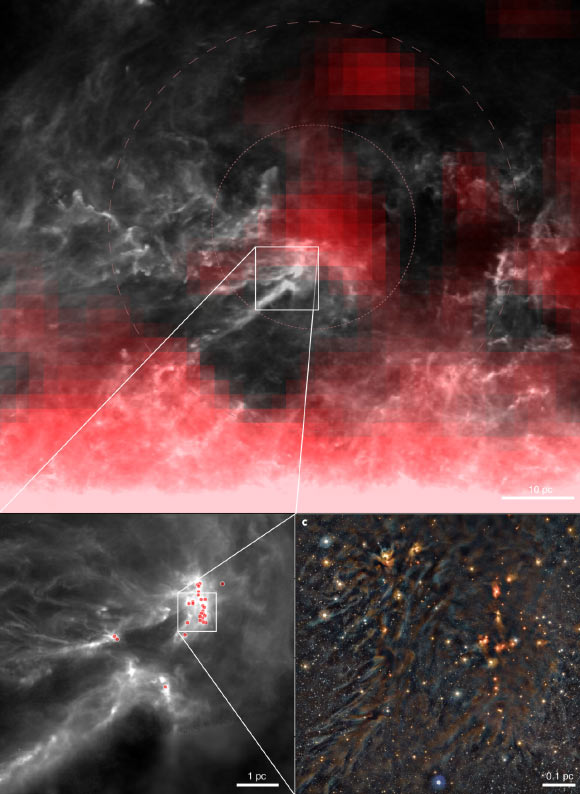
Ophiuchus Star-Forming Complex Hosts Analogues of Early Solar System, Astronomers Say | Astronomy
The Ophiuchus star-forming complex is a complex of interstellar clouds, nebulae and prestellar cores in the constellation of Ophiuchus. At an estimated distance of 427 light-years, it is one of the closest star-forming regions to our Solar System. A new study of the complex shows how our Solar System may have become enriched with short-lived radioactive elements. Evidence of this enrichment process has been around since the 1970s, when scientists studying certain mineral inclusions in meteorites concluded that they were pristine remnants of the infant Solar System and contained the decay products of short-lived radionuclides. These radioactive elements could have been blown onto the nascent Solar System by a nearby supernova or by the strong stellar winds from a type of massive star known as a Wolf-Rayet star.Multi-wavelength observations of the Ophiuchus star-forming region reveal interactions between clouds of star-forming gas and radionuclides produced in a nearby cluster of young stars. The top image (a) shows the distribution of aluminum-26 in red, traced by gamma-ray emissions. The central box represents the area covered in the bottom left image (b), which shows the distribution of protostars in the Ophiuchus clouds as red dots. The area in the box is shown in the bottom right image (c), a deep near-infrared color composite image of the L1688 cloud, containing many well known prestellar dense-gas cores with disks and protostars. Image credit: Forbes et al., doi: 10.1038/s41550-021-01442-9.Our Solar System was most likely formed in a giant molecular cloud together with a young stellar cluster, and one or more supernova events from some massive stars in this cluster contaminated the gas which turned into the Sun and its planetary system, said Professor Douglas Lin, a researcher in the Department of Astronomy and Astrophysics at the University of California, Santa Cruz, and the Institute for Advanced Studies at Tsinghua University.Although this scenario has been suggested in the past, the strength of our paper is to use multi-wavelength observations and a sophisticated statistical analysis to deduce a quantitative measurement of the models likelihood.The Ophiuchus star-forming complex contains many dense protostellar cores in various stages of star formation and protoplanetary disk development, representing the earliest stages in the formation of a planetary system.By combining imaging data in wavelengths ranging from millimeters to gamma rays, the astronomers were able to visualize a flow of aluminum-26 from the nearby star cluster toward the Ophiuchus complex.The enrichment process were seeing in Ophiuchus is consistent with what happened during the formation of the Solar System 5 billion years ago, said Dr. John Forbes, a researcher in the Center for Computational Astrophysics at Flatiron Institute.Once we saw this nice example of how the process might happen, we set about trying to model the nearby star cluster that produced the radionuclides we see today in gamma rays.The researchers developed a model that accounts for every massive star that could have existed in this region, including its mass, age, and probability of exploding as a supernova, and incorporates the potential yields of aluminum-26 from stellar winds and supernovae.The model enabled the team to determine the probabilities of different scenarios for the production of the aluminum-26 observed today.We now have enough information to say that there is a 59% chance it is due to supernovae and a 68% chance that its from multiple sources and not just one supernova, Dr. Forbes said.This type of statistical analysis assigns probabilities to scenarios that astronomers have been debating for the past 50 years, Professor Lin added.This is the new direction for astronomy, to quantify the likelihood.The findings also show that the amount of short-lived radionuclides incorporated into newly-forming star systems can vary widely.Many new star systems will be born with aluminum-26 abundances in line with our Solar System, but the variation is huge — several orders of magnitude, Dr. Forbes said.This matters for the early evolution of planetary systems, since aluminum-26 is the main early heating source. More aluminum-26 probably means drier planets.The findings appear in the journal Nature Astronomy._____J.C. Forbes et al. A Solar System formation analogue in the Ophiuchus star-forming complex. Nat Astron, published online August 16, 2021; doi: 10.1038/s41550-021-01442-9
……Space
Comments
Leave a comment in Nestia App